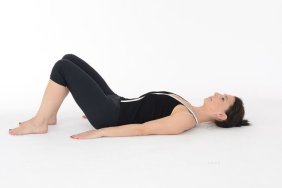We’re often guilty of seeking reward without effort, especially when it comes to exercise and weight loss. Motivating ourselves to go for a run when we’ve still got last night’s double fudge sundae digesting in our body can be a challenge, and this is something that becomes increasingly palpable as we head into the holiday season. There’s a reason we’re seeing a growing trend of no-workout workouts, like cryotherapy and EMS training, which purport to burn calories and bust fat with minimal to no effort. Infrared heat is the latest to join the fray and it can range from the completely passive, via a sauna, to active, via heated yoga. So, what is infrared heat and why are experts like Dr. Mehmet Oz and celebrities like Gwyneth Paltrow singing its praises?
What Is Infrared Heat?
Infrared light is the invisible part of natural sunlight that feels like heat when we are exposed to it. It’s completely safe (hospitals use it to warm newborns) and you can be exposed to it for hours since it’s devoid of harmful UV rays. Unlike the heat you find in traditional saunas and yoga rooms, in an infrared heated room, the heat is heating your body directly and only 20 percent of the heat is heating the air, meaning you’re not just sweating from heat, the heat is actually penetrating your skin.
Benefits of Infrared Heat
“Infrared pulls heavy metals, environmental pollutants and radiation from deep within the body that are stored in your fat cells,” says Richelle Oslinker of HigherDOSE, a spa offering infrared sauna sessions in New York City. “Infrared saunas have the ability to penetrate the skin more deeply, increasing metabolic rate and burn off anywhere from 200 to 600 calories in a half-hour session, resulting in amazing detox results.”
For yoga, infrared heat can be very helpful for warming the tissues and joints to help with flexibility during the class as well as joint and muscle health after class, according to Tiffany Cruikshank, L.A.c., MAOM, RYT, founder of Yoga Medicine and author of Meditate Your Weight. “We also see an important detoxifying effect on the body and it’s used for its ability to boost the immune system.” The only difference between infrared heat via sauna versus yoga is the physical activity taking place; there is no difference in the infrared heat itself. In either case, you can expect to burn calories because the heat is, according to Oslinker, causing your core body temperature to increase, which leads to an increased heart rate. “This causes the body to work harder to lower your core temperature or keep up with an increased heart rate, your body will burn more calories, resulting in weight loss.”
Cara Ann Senicola, a physical therapist at Hospital for Special Surgery and a certified yoga teacher, issues a note of caution. “Experts argue whether or not sweating is truly a detoxifier. Sweat is made up of mostly water with urea, salt and some other proteins. The kidneys are what traditionally detoxifies the blood and clears toxins from the body.” Senicola notes that while detox via heat may need more research, there are undeniable benefits of a post-workout infrared sauna session. “In a study using infrared devices, there was a decrease in exercise-induced muscle damage after running a simulated trail race, meaning that these saunas may be beneficial for delayed onset muscle soreness. I believe it would be worth a try after a workout.”
The beauty of this type of heat is that it’s fast-acting. You don’t need to spend more than 15 minutes to start feeling positive results. “Besides helping you relax after exercise and helping to speed up muscle recovery, sitting in a sauna post-workout for about 15 minutes will keep your metabolism at a higher rate for a longer period of time, which is especially beneficial if you’re trying to lose weight,” says Szilvia Sajtos, spa director at Harmony Spa at Aria Hotel Budapest.
If you’re on the fence, the experts we spoke with all said that benefits are usually visible after a single session. Aside from the aforementioned metabolic and post-workout benefits, it’s said to be great for skin and energy levels. “Infrared heat increases the circulation of the body. The increased circulation brings oxygen and nutrients to the skin surface, promoting healthy, glowing skin,” says Oslinker.
Risks of Infrared Heat
Note that like most new wellness-related trends, infrared heat is not without its risks. “The main danger is twofold, the first being the tendency to feel so relaxed and flexible that people overstretch and strain or tear the tissues,” cautions Cruikshank. “The second is that there is a fine balance of minerals and electrolytes in the body that can be pushed too far. Anytime you sweat a lot your body loses electrolytes and minerals and over time [that] can have an affect on the tissues.” The key is clearly moderation.
“Generally when you use the infrared saunas you are in there for 10 to 30 minutes whereas in yoga class you can be in there for 60 to 90 minutes and sweat a great deal more. If you’re doing yoga in an infrared room the heat should be moderate (less than 90 to 95 degrees) and you need to be sure to replace your electrolytes soon after just as you would in athletics.” Cruikshank also cautions that anyone with any cardiovascular conditions take extra precautions since the heat when combined with movement can stress the system. “In a healthy body this stress is an important healthy stress, which can be a key preventative measure for keeping the heart healthy, however, in suboptimal conditions, this can be too much.”
One thing is for sure, this trend sounds a lot more promising than the omnipresent juice fasts we’re hearing about everywhere.








